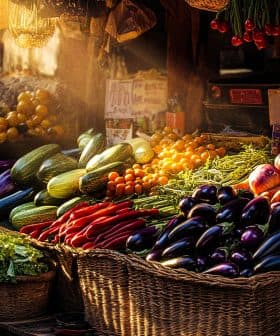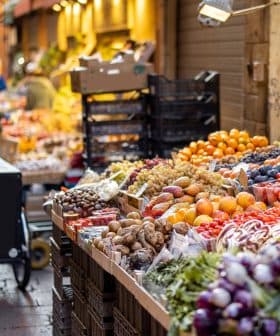New Research Reveals Impact of Malaxation on Olive Oil Phenolic Profile
Malaxation, the mixing of crushed olives during milling, greatly affects the phenolic profile of olive oil, impacting taste, stability, and health benefits.
New research suggests that the malaxation phase during olive oil production plays a significant role in determining the phenolic profile of the oil, especially secoiridoids. Factors such as temperature, time, oxygen exposure, and water addition during malaxation impact the content and profile of phenolic compounds, which are linked to the sensory and health properties of olive oil. The study emphasizes the importance of considering the olive cultivar, environment, and processing methods to optimize phenolic content and overall quality of extra virgin olive oil.
The slow, controlled mixing of the crushed olives during the milling process – the malaxation phase – might have a larger role in determining olive oil’s phenolic profile than previously thought.
New research published in Food Chemistry compiled years of studies on how malaxation temperature, time, oxygen exposure, and the addition of water impact the content and profile of polar phenolic compounds, especially secoiridoids, a subclass of phenols.
“These are the most representative phenolic class in olive oil, and they’re the ones most transformed during malaxation,” Ítala Marx, a postdoctoral researcher at the University of Córdoba and co-author of the research, told Olive Oil Times.
It’s not just about the cultivar anymore. It’s about cultivar, plus environment, plus processing. And if you want to make excellent extra virgin olive oil, you need to take into account all three.
During malaxation, larger precursor molecules, such as oleuropein and ligstroside, naturally produced by the fruits, are converted – biotransformed – by enzymes.
Those convey smaller, highly bioactive compounds such as oleocanthal and oleacein, which are linked to olive oil’s pungency, bitterness and antioxidant power.
Decades of research have shown that daily consumption of olive oil rich in phenols produces significant health benefits.
See Also:Short-Term Pre-Milling Refrigeration Found to Retain Olive QualityFurthermore, the complete phenolic profile of extra virgin olive oil is deeply intertwined with its aromas and flavors.
“Phenolics are responsible for bitterness and pungency. So if you increase them, you naturally improve sensory complexity,” Marx said. “The consumer wants that ‘green’ flavor, that bitterness. These are linked to the phenolic profile.”
“That’s why we focused on secoiridoids,” she explained.“They’re at the core of both the sensory experience and the health-related value of extra virgin olive oil.”
“I started this work during my PhD,” Marx added. “My program was completely developed in industrial olive oil mills. All campaigns, from 2019 to 2022, were focused on how to optimize extraction to improve oil’s phenolic content, and malaxation was the core of my research.”
The review paper focused on how the enzymatic biotransformation happens during malaxation and how sensitive the process is to malaxation conditions.
“Everything depends on the olive cultivar. You can’t apply the same temperature and time and expect the same result from different olives,” Marx remarked.
The influence of cultivar, or genotype, is perhaps the strongest variable. “Genotype is the main factor that impacts olive oil’s phenolic composition,” Marx said.
This was made evident by studies in which dozens of olive cultivars were grown under identical conditions and extracted using the same technology and procedure.
“They showed wide variation in phenolic profiles,” Marx said.
“Even Arbequina, usually considered low in phenolics, can surprise you,” she added, hinting at the profound impact that different farming environments can convey.
“If you extract oil from Arbequina in an intensive orchard, or from Arbequina in a traditional setup, the result will be completely different,” she explained.
Marx introduced research conducted in the Almeria desert, in Andalusia, where Arbequina and Picual olive varieties were cultivated in the same desert conditions.
“It’s a commercial brand. When we analyzed the olive oils, the Arbequina had over 1,000 milligrams per kilogram of phenols. That’s not typical,” she said.
According to Marx, the highly stressful environment of the desert boosted the phenolic synthesis.
“We saw the same happening with Arbequina cultivated in Brazil, amounts of phenolics higher than you’d expect,” she said.
Even more interesting than the total amount of phenols, it was the phenolic profile of the olive oils.
“We observed more oleacein and more oleocanthal in Arbequina compared to Picual. Meanwhile, Picual was richer in glucosides like oleuropein and ligstroside,” Marx said.
“The total amount may be similar, but the profile is different. And that impacts both sensory traits and oxidative stability,” she added.
The phenolic profile is essential. “Take oxidative stability. It is not just about how many phenolics are present, but which ones,” Marx said.
“Oleacein and oleocanthal, which Arbequina has more of, don’t stabilize oil as well as oleuropein glucoside, which is more common in Picual,” she added.
When it comes to milling the olives, these differences should be carefully considered.
“If you have Arbequina in an intensive orchard, and you know its usual phenolic weakness, you might invest in technologies like pulsed electric fields or oxygen control to improve it,” Marx said.
See Also:Research Explores Olive Oil Co-Extraction with Olive Leaves, Herbs and Spices“But if you’re working with Arbequina from a traditional, stressed environment, you may already be starting with a higher phenolic baseline,” she added.
These nuanced differences point towards a future of tailored extraction strategies.
“It’s not just about the cultivar anymore. It’s about cultivar, plus environment, plus processing,” Marx said. “And if you want to make excellent extra virgin olive oil, you need to take into account all three.”
The paper examined how malaxation temperature and time impact phenolic content.
Studies have shown that moderate temperatures between 20°C and 30°C generally promote better extraction of phenolics, while excessive heat leads to degradation.
“The effect follows a bell shape. We reach an optimal point, often around 20 to 30 minutes of malaxation, and then phenolic content starts to drop,” Marx said. “Longer malaxation promotes oxidation, degradation and enzymatic breakdown of phenolics.”
Still, the olive cultivar is always worth considering.
“You can’t say 25 °C and 30 minutes is always best. For some cultivars, like Arbequina, 45 minutes at 25 °C may work better,” she explained, hinting at the specific analyses on specific cultivars cited in the review paper.
One of the most transformative findings was related to oxygen. “Oxygen promotes phenolic degradation,” Marx noted.
“So when we eliminate it, by using vacuum systems or even controlling the oxygen atmosphere, we can retain more phenolics in olive oil,” she added.
More specifically, some industrial-scale tests using high vacuum during malaxation showed increases of 25 to 48 percent in phenolic content, especially in secoiridoid derivatives.
Even partial oxygen control can help.
“Just reducing the headspace oxygen in the malaxer chamber can make a difference. And cultivars respond differently, some are more sensitive than others,” she remarked.
Many milling processes are carried out by adding water. It is a common way to control the consistency of olive paste, which is what results from crushing olives, and an easy way to improve yield.
But research confirmed that it comes with a hidden cost.
“We tested different amounts of water in industrial mills, again with Arbequina,” Marx said. “And without water, we obtained olive oils with higher phenolic content.”
The reason is chemical. Phenols are hydrophilic. When water is added to the olive oil paste in the malaxer, the water takes the phenolic compounds from the paste.
“If we don’t add water, we have the chance to retain them, to have them stay with the olive oil,” Marx explained.
The research demonstrated the promise of recent, non-thermal extraction technologies.
“Pulsed electric fields, ultrasound and microwaves. All of these can increase both phenolic content and olive oil yield. And unlike traditional methods, they don’t degrade the sensory profile,” Marx said.
Adding temperature, time, or water to improve yields is a well-established practice at many olive oil mills.
“Yes, that worked for yield, but destroyed the phenolics and the taste,” Marx said. “Now, with these new technologies, we can have both: higher phenolics and better sensory attributes.”
Overall, the phenolic profile and total phenols combine to determine an olive oil’s stability, taste and health benefits. Marx pointed out that the research will continue.
“We need to move toward cultivar-specific guidelines,” she concluded. “With the data we have now, and the technology available, it’s possible to produce excellent olive oils, even from cultivars not traditionally known for phenolics.”
Share this article









